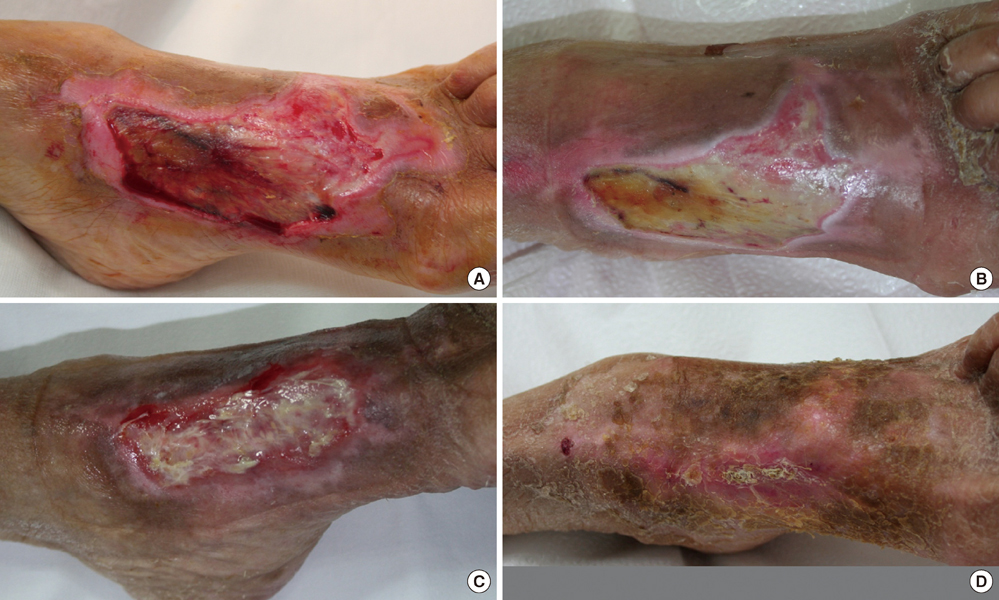J Korean Med Sci.
2012 Dec;27(12):1604-1606. 10.3346/jkms.2012.27.12.1604.
Recalcitrant Cutaneous Ulcer of Comorbid Patient Treated with Platelet Rich Plasma: A Case Report
- Affiliations
-
- 1Department of Dermatology, Korea University College of Medicine, Seoul, Korea. grace79@korea.ac.kr
- KMID: 2157992
- DOI: http://doi.org/10.3346/jkms.2012.27.12.1604
Abstract
- The platelet-rich plasma (PRP) has been advocated as a way to introduce increased concentrations of growth factors and other bioactive molecules to injured tissues in an attempt to optimize the local healing environment. A 94-yr-old woman with various comorbidities presented with a two-week history of severe cutaneous ulcer on the left dorsum of foot. It was caused by recurrent mechanical trauma and did not respond to several wound debridement and simple dressings. However, after she was completed on seven times of autologous PRP treatments, we observed complete healing of the skin lesion within 3 months. Herein, we report a case of recalcitrant cutaneous ulcer with various comorbidities and discuss about the promising possibility of autologous PRP as an effective alternative therapeutic modality.
Keyword
MeSH Terms
Figure
Reference
-
1. Bernuzzi G, Tardito S, Bussolati O, Adorni D, Cantarelli S, Fagnoni F, Rossetti A, Azzarone M, Ficarelli E, Caleffi E, et al. Platelet gel in the treatment of cutaneous ulcers: the experience of the immunohaematology and Transfusion Center of Parma. Blood Transfus. 2010. 8:237–247.2. Orcajo B, Muruzabal F, Isasmendi MC, Gutierrez N, Sanchez M, Orive G, Anitua E. The use of plasma rich in growth factors in the treatment of a severe mal perforant ulcer in the foot of a person with diabetes. Diabetes Res Clin Pract. 2011. 93:e65–e67.3. De Leon JM, Driver VR, Fylling CP, Carter MJ, Anderson C, Wilson J, Dougherty RM, Fuston D, Trigilla D, Valenski V, et al. The clinical relevance of treating chronic wounds with an enhanced near-physiological concentration of platelet-rich plasma gel. Adv Skin Wound Care. 2011. 24:357–368.4. Kim DH, Je YJ, Kim CD, Lee YH, Seo YJ, Lee JH, Lee Y. Can platelet-rich plasma be used for skin rejuvenation? Evaluation of effects of platelet-rich plasma on human dermal fibroblast. Ann Dermatol. 2011. 23:424–431.5. Sell SA, Ericksen JJ, Reis TW, Droste LR, Bhuiyan MB, Gater DR. A case report on the use of sustained release platelet-rich plasma for the treatment of chronic pressure ulcers. J Spinal Cord Med. 2011. 34:122–127.6. Villela DL, Santos VL. Evidence on the use of platelet-rich plasma for diabetic ulcer: a systemic review. Growth Factors. 2010. 28:111–116.7. Jeong KH, Shin MK, Kim NI. Refractory lipodermatosclerosis treated with intralesional platelet-rich plasma. J Am Acad Dermatol. 2011. 65:e157–e158.8. Pallua N, Wolter T, Markowicz M. Platelet-rich plasma in burns. Burns. 2010. 36:4–8.9. Greppi N, Mazzucco L, Galetti G, Bona F, Petrillo E, Smacchia C, Raspollini E, Cossovich P, Caprioli R, Borzini P, et al. Treatment of recalcitrant ulcers with allogenic platelet gel from pooled platelets in aged hypomobile patients. Biologicals. 2011. 39:73–80.
- Full Text Links
- Actions
-
Cited
- CITED
-
- Close
- Share
- Similar articles
-
- A Case of Recalcitrant Ulcer Treated with Platelet-rich Plasma Therapy in a Patient with Phakomatosis Pigmentovascularis Type IIb
- Intralesional Injection of Autologous Platelet-Rich Plasma as an Effective Regeneration Therapy: A Case Report of Chronic Wagner Grade 2 Diabetic Foot Ulcer
- Treatment of Recalcitrant Medial and Lateral Epicondylitis with Autologous Platelet Rich Plasma; Preliminary Report
- A Case of Pyoderma Gangrenosum Treated by Combination Therapy with Oral Cyclosporin and Platelet Rich Plasma
- Successful Treatment of Nicolau Syndrome with Platelet Rich Plasma


